Samsung EV-NX300ZBSVUS, EV-NX300ZBSTUS, NX300, EV-NX300ZBQUUS User Manual
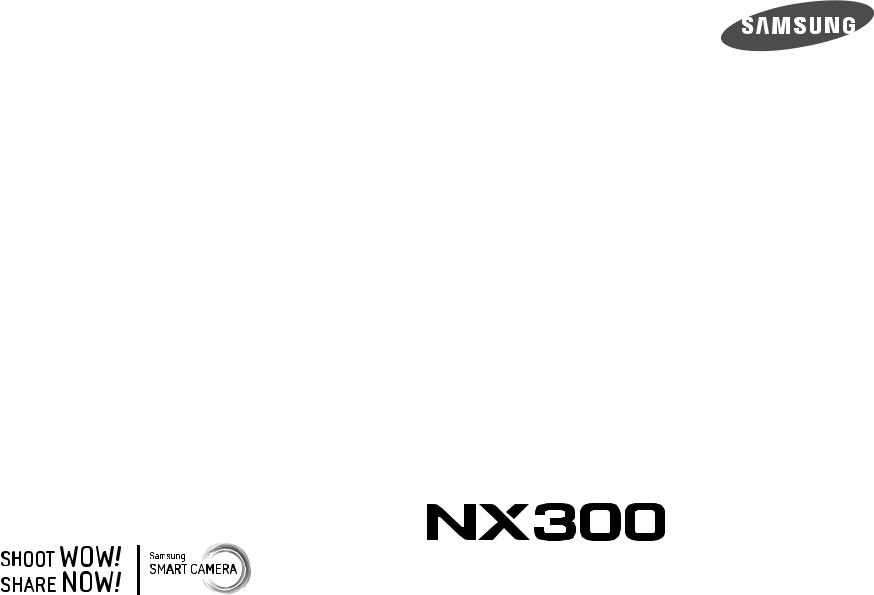
USER
MANUAL
ENG This user manual includes detailed usage instructions for your camera. Please read this manual thoroughly.

Copyright information
•Microsoft Windows and the Windows logo are registered trademarks of the Microsoft Corporation.
•Mac and Apple App Store are registered trademarks of the Apple Corporation.
•Google Play Store is a registered trademark of Google, Inc.
•Adobe, the Adobe logo, Photoshop and Lightroom are either registered trademarks or trademarks of Adobe Systems Incorporated in the United States and/or other countries.
•microSD™, microSDHC™, and microSDXC™ are registered trademarks of the SD Association.
• HDMI, the HDMI logo, and the term “High Definition Multimedia Interface” are trademarks or registered trademarks of HDMI Licensing LLC.
•Wi-Fi®, the Wi-Fi CERTIFIED logo, and the Wi-Fi logo are registered trademarks of the Wi-Fi Alliance.
•Trademarks and trade names used in this manual are the property of their respective owners.
•Camera specifications or contents of this manual may be changed without prior notice due to upgrade of camera functions.
•You are not allowed to reuse or distribute any part of this manual without prior permission.
•We recommend using your camera within the country where you purchase it.
•Use this camera responsibly and adhere to all laws and regulations concerning its use.
PlanetFirst represents Samsung Electronics' commitment to sustainable development and social responsibility through eco-driven business and management activities.
1

Health and safety information
Always comply with the following precautions and usage tips to avoid dangerous situations and ensure peak performance of your camera.
Warning—situations that could cause injury to yourself or others
Do not disassemble or attempt to repair your camera.
This may result in electric shock or damage to the camera.
Do not use your camera near flammable or explosive gases and liquids.
This may cause a fire or explosion.
Do not insert flammable materials into the camera or store these materials near the camera.
This may cause a fire or electric shock.
Do not handle your camera with wet hands.
This may result in electric shock.
Prevent damage to subjects’ eyesight.
Do not use the flash in close proximity (closer than 1 m/3 ft) to people or animals. If you use the flash too close to your subject’s eyes, this can cause temporary or permanent eyesight damage.
Keep your camera away from small children and pets.
Keep your camera and all accessories out of the reach of small children and animals. Small parts may cause choking or serious injury if swallowed. Moving parts and accessories may present physical dangers as well.
Do not expose the camera to direct sunlight or high temperatures for an extended period of time.
Prolonged exposure to sunlight or extreme temperatures can cause permanent damage to your camera’s internal components.
Avoid covering the camera or charger with blankets or clothes.
The camera may overheat, which may distort the camera or cause a fire.
Do not handle the power supply cord or go near the charger during a thunderstorm.
This may result in electric shock.
2

Health and safety information
If liquid or foreign objects enter your camera, immediately disconnect all power sources, such as the battery or charger, and then contact a Samsung service center.
Comply with any regulations that restrict the use of a camera in a certain area.
•Avoid interference with other electronic devices.
•Turn off the camera when in an aircraft. Your camera can cause interference with aircraft equipment. Follow all airline regulations and turn off your camera when directed by airline personnel.
•Turn off the camera near medical equipment. Your camera can interfere with medical equipment in hospitals or health care facilities. Follow all regulations, posted warnings, and directions from medical personnel.
Avoid interference with pacemakers.
Maintain the distance between this camera and all pacemakers to avoid potential interference, as recommended by the manufacturer and research groups. If you have any reason to suspect that your camera is interfering with a pacemaker or other medical device, turn off the camera immediately and contact the manufacturer of the pacemaker or medical device for guidance.
Caution—situations that could cause damage to your
camera or other equipment
Remove the batteries from your camera when storing it for an extended period of time.
Installed batteries may leak or corrode over time and cause serious damage to your camera.
Use only authentic, manufacturer-recommended, Lithium-ion replacement batteries. Do not damage or heat the battery.
Inauthentic, damaged, or heated batteries may cause a fire or personal injury.
Use only Samsung-approved batteries, chargers, cables and accessories.
•Using unauthorized batteries, chargers, cables or accessories can cause batteries to explode, damage your camera, or cause injury.
•Samsung is not responsible for damage or injuries caused by unapproved batteries, chargers, cables or accessories.
Use the battery only for its intended purpose.
Misusing the battery may cause a fire or electric shock.
3
Health and safety information
Do not touch the flash while it fires.
The flash is very hot when fired and may burn your skin.
When you use the AC charger, turn off the camera before you disconnect the power to the AC charger.
Failing to do so may result in fire or electric shock.
Disconnect the charger from the wall socket when not in use.
Failing to do so may result in fire or electric shock.
Do not use a damaged power supply cord, plug, or loose outlet when you charge batteries.
This may cause a fire or electric shock.
Do not allow the AC charger to come in contact with the +/- terminals on the battery.
This may cause a fire or electric shock.
Do not drop or subject the camera to strong impacts.
Doing so may damage the screen or external or internal components.
Exercise caution when you connect cables and install batteries and memory cards.
If you force the connectors, improperly connect cables, or improperly install batteries and memory cards, you can damage ports, connectors, and accessories.
Keep cards with magnetic strips away from the camera case.
Information stored on the card may be damaged or erased.
Never use a damaged battery, or memory card.
This may result in electric shock or camera malfunction or cause a fire.
Do not place the camera in or near magnetic fields.
Doing so may cause the camera to malfunction.
Do not use the camera if the screen is damaged.
If the glass or acrylic parts are broken, visit a Samsung service center to have the camera repaired.
4

Health and safety information
Check that the camera is operating properly before use.
The manufacturer takes no responsibility for any loss of files or damage that may result from camera malfunction or improper use.
You must plug the small end of the USB cable into your camera.
If the cable is reversed, it may damage your files. The manufacturer is not responsible for any loss of data.
Do not expose the lens to direct sunlight.
This may discolor the image sensor or cause it to malfunction.
If the camera overheats, remove the battery and allow it to cool down.
•Prolonged usage of the camera may overheat the battery and raise the internal temperature of the camera. If the camera stops operating, remove the battery and allow it to cool down.
•High internal temperatures may result in noise in your photos. This is normal and does not affect your camera’s overall performance.
Avoid interference with other electronic devices.
Your camera emits radio frequency (RF) signals that may interfere with unshielded or improperly shielded electronic equipment, such as
pacemakers, hearing aids, medical devices, and other electronic devices in homes or vehicles. Consult the manufacturers of your electronic devices to solve any interference problems you experience. To prevent unwanted interference, use only Samsung-approved devices or accessories.
Use your camera in the normal position.
Avoid contact with your camera’s internal antenna.
Data transference and your responsibilities
•Data transferred via WLAN could be leaked, so avoid transferring sensitive data in public areas or on open networks.
•The camera manufacturer is not liable for any data transfers that infringe on copyrights, trademarks, intellectual property laws, or public decency ordinances.
5

Indications used in this manual
Icons used in this manual
Icon |
|
Function |
|
|
|
Additional information |
|
|
|
|
|
|
|
Safety warnings and precautions |
|
|
|
|
|
[ |
] |
Camera buttons. For example, [Shutter] represents the |
|
shutter button. |
|||
|
|
() Page number of related information
The order of options or menus you must select to perform
→a step; for example: Select 1 →Quality (represents select 1, and then Quality).
*Annotation
Mode indications
Mode |
Indication |
Smart Auto |
t |
|
|
Program |
P |
|
|
Aperture Priority |
A |
|
|
Shutter Priority |
S |
|
|
Manual |
M |
|
|
Lens Priority |
i |
|
|
Smart |
s |
|
|
Wi-Fi |
B |
|
|
6

Contents
Tips |
|
Concepts in Photography |
|
Shooting postures....................................................................................... |
13 |
Holding the camera ..................................................................................................... |
13 |
Standing photography ............................................................................................... |
13 |
Crouching photography ............................................................................................ |
14 |
Using the display .......................................................................................................... |
14 |
Low-angle shot.............................................................................................................. |
15 |
High-angle shot............................................................................................................. |
15 |
Aperture........................................................................................................ |
16 |
Aperture value and the depth of field .................................................................. |
17 |
Shutter speed............................................................................................... |
18 |
ISO sensitivity .............................................................................................. |
19 |
How the aperture setting, shutter speed, and ISO sensitivity |
|
control exposure ......................................................................................... |
20 |
Correlation between focal length, angle, and perspective................ |
21 |
Depth of field ............................................................................................... |
22 |
What controls out-of-focus effects?....................................................................... |
22 |
Optical preview ............................................................................................................. |
24 |
Composition................................................................................................. |
24 |
Rule of Thirds.................................................................................................................. |
24 |
Photos with two subjects .......................................................................................... |
25 |
Flash............................................................................................................... |
26 |
Flash guide number..................................................................................................... |
26 |
Bounce Photography .................................................................................................. |
27 |
Chapter 1 |
|
My Camera |
|
Getting started ............................................................................................ |
29 |
Unpacking.................................................................................................................... |
29 |
Camera layout.............................................................................................. |
30 |
Using the DIRECT LINK button................................................................................ |
32 |
Inserting the battery and memory card................................................. |
33 |
Removing the battery and memory card ........................................................... |
33 |
Using the memory card adapter............................................................................. |
33 |
Charging the battery and turning on your camera.............................. |
34 |
Charging the battery................................................................................................ |
34 |
Turning on your camera ......................................................................................... |
34 |
Performing the initial setup...................................................................... |
35 |
Selecting functions (options) ................................................................... |
36 |
Selecting with buttons............................................................................................ |
36 |
Selecting by touch.................................................................................................... |
36 |
Using m.............................................................................................................. |
37 |
E.g. Selecting the photo size in P mode ............................................................. |
37 |
Using the Smart panel............................................................................................. |
38 |
E.g. Adjust the exposure value in P mode ......................................................... |
38 |
7
Contents |
|
Display icons ................................................................................................ |
40 |
In Shooting mode ..................................................................................................... |
40 |
Capturing photos ........................................................................................................ |
40 |
Recording videos ......................................................................................................... |
41 |
About the level gauge ............................................................................................... |
41 |
In Playback mode...................................................................................................... |
42 |
Viewing photos ............................................................................................................ |
42 |
Playing videos............................................................................................................... |
42 |
Changing the information displayed................................................................. |
43 |
Lenses............................................................................................................ |
44 |
Lens layout................................................................................................................... |
44 |
Locking or unlocking the lens................................................................................. |
45 |
Lens markings ............................................................................................................ |
47 |
Accessories ................................................................................................... |
48 |
External flash layout................................................................................................. |
48 |
Connecting the external flash................................................................................. |
49 |
GPS module layout (optional) .............................................................................. |
51 |
Attaching the GPS module .................................................................................... |
51 |
Shooting modes .......................................................................................... |
53 |
t Smart Auto mode ..................................................................................... |
53 |
P Program mode....................................................................................................... |
55 |
Program Shift ................................................................................................................ |
56 |
Minimum shutter speed............................................................................................ |
56 |
A Aperture Priority mode ..................................................................................... |
57 |
S Shutter Priority mode.......................................................................................... |
58 |
M Manual mode ....................................................................................................... |
59 |
Framing mode .............................................................................................................. |
59 |
Using the Bulb function ............................................................................................ |
60 |
i Lens Priority mode............................................................................................. |
60 |
Using E............................................................................................................. |
60 |
Using i-Function in P/A/S/M modes ................................................................ |
61 |
Using Z.............................................................................................................. |
63 |
s Smart mode ........................................................................................................ |
64 |
Using the Best Face mode ........................................................................................ |
65 |
Capturing panoramic photos.................................................................................. |
66 |
Recording a video ..................................................................................................... |
68 |
3D mode....................................................................................................................... |
69 |
Available functions by shooting mode ............................................................. |
71 |
8
Contents |
|
Chapter 2 |
|
Shooting Functions |
|
Size and Resolution .................................................................................... |
73 |
Photo size..................................................................................................................... |
73 |
Quality........................................................................................................................... |
74 |
ISO sensitivity .............................................................................................. |
75 |
White Balance .............................................................................................. |
76 |
Customizing preset White Balance options ....................................................... |
77 |
Picture Wizard (photo styles).................................................................... |
79 |
AF mode........................................................................................................ |
80 |
Single AF....................................................................................................................... |
81 |
Continuous AF............................................................................................................ |
81 |
Manual focus............................................................................................................... |
82 |
AF area........................................................................................................... |
83 |
Selection AF ................................................................................................................ |
83 |
Multi AF......................................................................................................................... |
84 |
Face detection AF...................................................................................................... |
84 |
Self-Portrait AF ........................................................................................................... |
85 |
Touch AF........................................................................................................ |
86 |
Touch AF....................................................................................................................... |
86 |
AF Point......................................................................................................................... |
86 |
Tracking AF.................................................................................................................. |
86 |
One touch shot .......................................................................................................... |
87 |
Focus assist................................................................................................... |
88 |
MF Assist....................................................................................................................... |
88 |
Focus Peaking............................................................................................................. |
88 |
Optical Image Stabilization (OIS)............................................................. |
89 |
|
Drive (shooting method)........................................................................... |
90 |
|
Single............................................................................................................................. |
90 |
|
Continuous.................................................................................................................. |
90 |
|
Burst............................................................................................................................... |
91 |
|
Timer.............................................................................................................................. |
91 |
|
Auto Exposure Bracketing (AE Bracket)............................................................. |
92 |
|
White Balance Bracketing (WB Bracket)............................................................ |
92 |
|
Picture Wizard Bracketing (P Wiz Bracket)........................................................ |
93 |
|
Bracketing setting..................................................................................................... |
93 |
|
Flash............................................................................................................... |
94 |
|
Reducing the red-eye effect.................................................................................. |
95 |
|
Adjusting the flash intensity ................................................................................. |
95 |
|
Metering........................................................................................................ |
97 |
|
Multi............................................................................................................................... |
97 |
|
Spot................................................................................................................................ |
98 |
|
Center-weighted ....................................................................................................... |
98 |
|
Measuring the exposure value of the focus area ........................................... |
99 |
|
Dynamic Range ......................................................................................... |
100 |
|
Smart Filter................................................................................................. |
101 |
|
Exposure compensation.......................................................................... |
102 |
|
Exposure lock............................................................................................. |
103 |
|
Video functions ......................................................................................... |
104 |
|
Movie size.................................................................................................................. |
104 |
|
Movie quality........................................................................................................... |
104 |
|
Multi Motion ............................................................................................................ |
105 |
|
Fader ........................................................................................................................... |
105 |
|
Voice............................................................................................................................ |
106 |
|
Wind cut .................................................................................................................... |
106 |
|
Mic Level.................................................................................................................... |
106 |
9 |
Contents |
|
Chapter 3 |
|
Playback/Editing |
|
Searching and managing files................................................................ |
108 |
Viewing photos....................................................................................................... |
108 |
Viewing image thumbnails................................................................................. |
108 |
Viewing files by category .................................................................................... |
109 |
Viewing files as a folder........................................................................................ |
109 |
Protecting files ........................................................................................................ |
110 |
Lock/Unlock all files .................................................................................................. |
110 |
Deleting files............................................................................................................ |
111 |
Deleting a single file................................................................................................. |
111 |
Deleting multiple files.............................................................................................. |
111 |
Deleting all files.......................................................................................................... |
112 |
Viewing photos.......................................................................................... |
113 |
Enlarging a photo .................................................................................................. |
113 |
Viewing a slide show............................................................................................. |
113 |
Auto rotating ........................................................................................................... |
114 |
Creating a print order (DPOF)............................................................................ |
114 |
Playing videos............................................................................................ |
115 |
Trimming a video during playback.................................................................. |
115 |
Capturing an image during playback............................................................. |
116 |
Editing photos ........................................................................................... |
117 |
Cropping a photo................................................................................................... |
117 |
Rotating a photo .................................................................................................... |
118 |
Resizing photos....................................................................................................... |
118 |
Adjusting your photos.......................................................................................... |
119 |
Retouching faces.................................................................................................... |
120 |
Reducing red-eye................................................................................................... |
120 |
Applying Smart Filter effects.............................................................................. |
121 |
Chapter 4 |
|
Wireless network |
|
Connecting to a WLAN and configuring network settings............... |
123 |
Connecting to a WLAN......................................................................................... |
123 |
Setting network options ......................................................................................... |
124 |
Manually setting the IP address ........................................................................... |
124 |
Using the login browser....................................................................................... |
125 |
Network connection tips..................................................................................... |
126 |
Entering text ............................................................................................................ |
127 |
Saving files to a smart phone automatically....................................... |
128 |
Sending photos or videos to a smart phone....................................... |
129 |
Using a smart phone as a remote shutter release.............................. |
131 |
Using Auto Backup to send photos or videos ..................................... |
133 |
Installing the program for Auto Backup on your PC.................................. |
133 |
Sending photos or videos to a PC.................................................................... |
133 |
Sending photos or videos via email...................................................... |
135 |
Changing email settings...................................................................................... |
135 |
Storing your information ........................................................................................ |
135 |
Setting an email password..................................................................................... |
136 |
Changing the email password.............................................................................. |
137 |
Sending photos or videos via email ................................................................ |
137 |
Using photo or video sharing websites................................................ |
139 |
Accessing a website .............................................................................................. |
139 |
Uploading photos or videos............................................................................... |
140 |
Using AllShare Play to send files............................................................ |
141 |
Uploading photos to online storage............................................................... |
141 |
Viewing photos or videos on devices that support AllShare Play........ |
142 |
Sending photos using Wi-Fi Direct........................................................ |
144 |
10
Contents |
|
Chapter 5 |
|
Camera settings menu |
|
User settings............................................................................................... |
146 |
ISO Customizing ..................................................................................................... |
146 |
ISO Step......................................................................................................................... |
146 |
Auto ISO Range .......................................................................................................... |
146 |
Noise Reduction ..................................................................................................... |
146 |
Bracket Set................................................................................................................ |
147 |
DMF (Direct Manual Focus) ................................................................................ |
147 |
Color space............................................................................................................... |
148 |
Distortion Correct .................................................................................................. |
149 |
Touch Operation..................................................................................................... |
149 |
iFn Customizing...................................................................................................... |
149 |
User Display.............................................................................................................. |
149 |
Key Mapping............................................................................................................ |
150 |
Grid Line .................................................................................................................... |
151 |
AF Lamp..................................................................................................................... |
151 |
Setting ......................................................................................................... |
152 |
Chapter 6 |
|
Connecting to external devices |
|
Viewing files on an HDTV or 3D TV........................................................ |
158 |
Viewing files on an HDTV .................................................................................... |
158 |
Viewing files on a 3D TV....................................................................................... |
159 |
Transferring files to your computer....................................................... |
160 |
Transferring files to your Windows OS computer....................................... |
160 |
Connecting the camera as a removable disk................................................... |
160 |
Disconnecting the camera (for Windows XP).................................................. |
161 |
Transferring files to your Mac OS...................................................................... |
161 |
Using programs on a PC........................................................................... |
163 |
Installing programs from the provided CD................................................... |
163 |
Available programs when using i-Launcher .................................................... |
163 |
Using i-Launcher .................................................................................................... |
163 |
Requirements for Windows OS............................................................................. |
163 |
Requirements for Mac OS....................................................................................... |
164 |
Opening i-Launcher.................................................................................................. |
164 |
Using Multimedia Viewer........................................................................................ |
165 |
Downloading the firmware.................................................................................... |
166 |
Downloading the PC Auto Backup program ................................................... |
166 |
Installing Adobe Photoshop Lightroom........................................................ |
167 |
Using Adobe Photoshop Lightroom............................................................... |
167 |
11
Contents |
|
Chapter 7 |
|
Appendix |
|
Error messages .......................................................................................... |
169 |
Maintaining the camera........................................................................... |
170 |
Cleaning the camera............................................................................................. |
170 |
Camera lens and display ......................................................................................... |
170 |
Image sensor............................................................................................................... |
170 |
Camera body............................................................................................................... |
170 |
Using or storing the camera............................................................................... |
171 |
Inappropriate places to use or store the camera ........................................... |
171 |
Using on beaches or shores................................................................................... |
171 |
Storing for extended period of time................................................................... |
171 |
Using the camera with caution in humid environments ............................ |
172 |
Other cautions............................................................................................................ |
172 |
About memory card.............................................................................................. |
173 |
Supported memory card ........................................................................................ |
173 |
Memory card capacity ............................................................................................. |
174 |
Cautions when using memory cards.................................................................. |
176 |
About the battery .................................................................................................. |
177 |
Battery specifications............................................................................................... |
177 |
Battery life .................................................................................................................... |
178 |
Low battery message ............................................................................................... |
178 |
Notes about using the battery.............................................................................. |
178 |
Cautions about using the battery........................................................................ |
179 |
Notes about charging the battery....................................................................... |
179 |
Notes about charging with a computer connected...................................... |
180 |
Handle and dispose of batteries and chargers with care............................ |
180 |
Before contacting a service center ........................................................ |
181 |
Camera specifications .............................................................................. |
184 |
Glossary....................................................................................................... |
189 |
Optional accessories................................................................................. |
195 |
Index ............................................................................................................ |
197 |
FCC notice................................................................................................... |
200 |
12

Concepts in Photography
Shooting postures
A correct posture for stabilizing the camera is necessary for taking a good photo. Even if you hold a camera correctly, the wrong posture can cause the camera to shake. Stand up straight and remain still to maintain a steady base for your camera. When shooting with a slow shutter speed, hold your breath to minimize body movement.
Holding the camera
Hold the camera with your right hand and place you right index finger on the shutter button. Place your left hand under the lens for support.
Standing photography
Compose your shot; stand up straight with your feet shoulder-length apart, and keep your elbows pointed down.
13
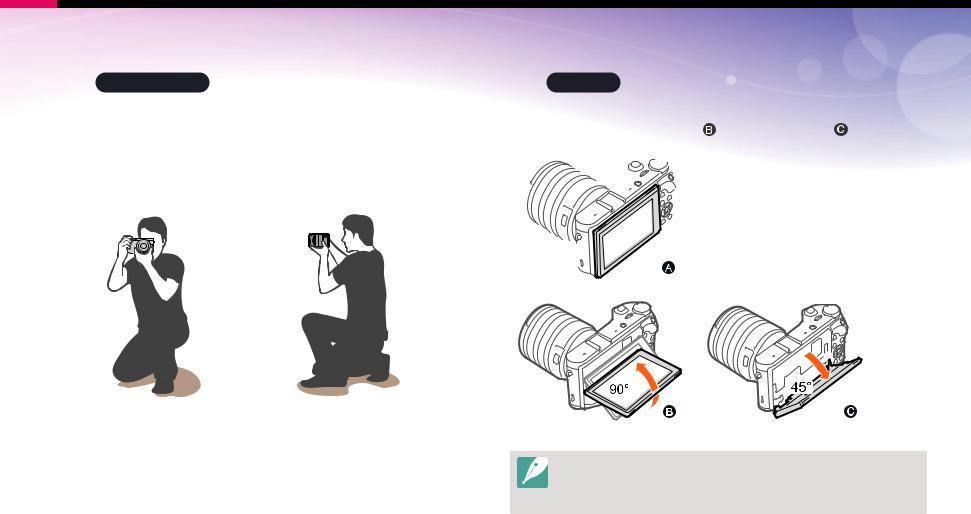
Concepts in Photography
|
Crouching photography |
|
|
|
|
|
Using the display |
|
|
|
|
|
|
|
|
Compose your shot, crouch with one knee touching the ground, and keep |
To take photos at high or low angles, tilt the display up or down. You can |
||||||||||||||
a straight posture. |
tilt the display up to 90° upwards ( ) or 45° downwards ( ). |
||||||||||||||
|
|
|
|
|
|
|
|
|
|
|
|
|
|
|
|
|
|
|
|
|
|
|
|
|
|
|
|
|
|
|
|
|
|
|
|
|
|
|
|
|
|
|
|
|
|
|
|
|
|
|
|
|
|
|
|
|
|
|
|
|
|
|
|
|
|
|
|
|
|
|
|
|
|
|
|
|
|
|
|
|
|
|
|
|
|
|
|
|
|
|
|
|
|
|
|
|
|
|
|
|
|
|
|
|
|
|
|
|
|
|
|
|
|
|
|
|
|
|
|
|
|
|
|
|
|
|
|
|
|
|
|
|
|
|
|
|
|
|
|
|
|
|
|
|
|
|
|
|
|
|
|
|
|
|
|
|
|
|
|
• Keep the display closed ( ) when the camera is not in use.
) when the camera is not in use.
• Tilt the display only within the angle allowed. Failing to do so may damage your camera.
14
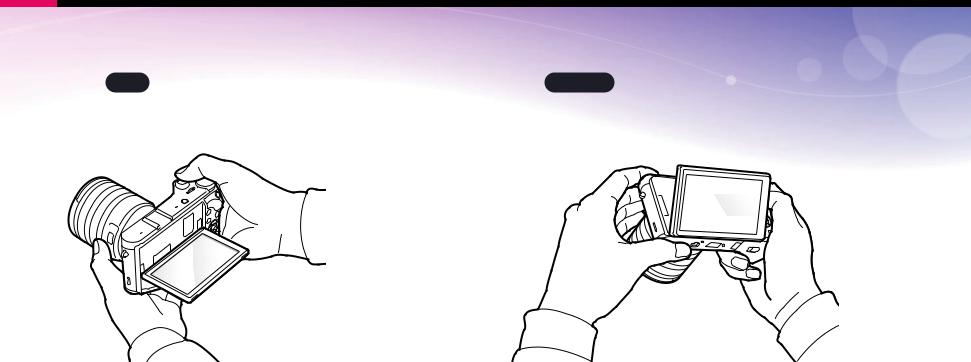
Concepts in Photography
|
Low-angle shot |
|
|
High-angle shot |
|
A low-angle shot is a shot from a camera positioned below your eyeline, |
A high-angle shot is a shot from a camera positioned above your eyeline, |
||||
looking up the subject. |
looking down on the subject. |
||||
15

Concepts in Photography
Aperture
The aperture, a hole that controls the amount of light that enters the camera, is one of the three factors that determine the exposure. The aperture housing contains thin, metal plates that open and close to let light through the aperture and into the camera. The size of the aperture is closely related to the brightness of a photo: the larger the aperture, the brighter the photo; the smaller the aperture, the darker the photo.
Aperture sizes
Minimum aperture |
Medium aperture |
Maximum aperture |
|
|
|
The size of the aperture is represented by a value known as an “F-number.” The f-number represents the focal length divided by the diameter of the lens. For example, if a lens with a 50 mm focal length has an f-number of F2, the diameter of the aperture is 25 mm. (50 mm/25 mm=F2) The smaller the f-number, the greater the size of the aperture.
The opening in the aperture is described as the Exposure Value (EV). Increasing the Exposure Value (+1 EV) means the amount of light doubles. Decreasing the Exposure Value (-1 EV) means the amount of light halves. You can also use the exposure compensation feature to fine-tune the amount of light by subdividing exposure values into 1/2, 1/3 EV, and so on.
+1 EV |
-1 EV |
F1.4 |
F2 |
F2.8 |
F4 |
F5.6 |
F8 |
Exposure Value Steps
Darker photo |
Brighter photo |
(aperture opened slightly) |
(aperture opened wide) |
16

Concepts in Photography
Aperture value and the depth of field
You can blur or sharpen the background of a photo by controlling the aperture. It is closely related to the depth of field (DOF), which can be expressed as small or large.
A photo with a large DOF |
A photo with a small DOF |
The aperture housing contains several blades. These blades move together and control the amount of light passing through the center of the aperture. The number of blades also affects the shape of light when shooting night scenes. If an aperture has an even number of blades, light divides into an equal number of sections. If the number of blades is odd, the number of sections is double the number of blades.
For example, an aperture with 8 blades divides light into 8 sections and an aperture with 7 blades into 14 sections.
7 blades |
8 blades |
17
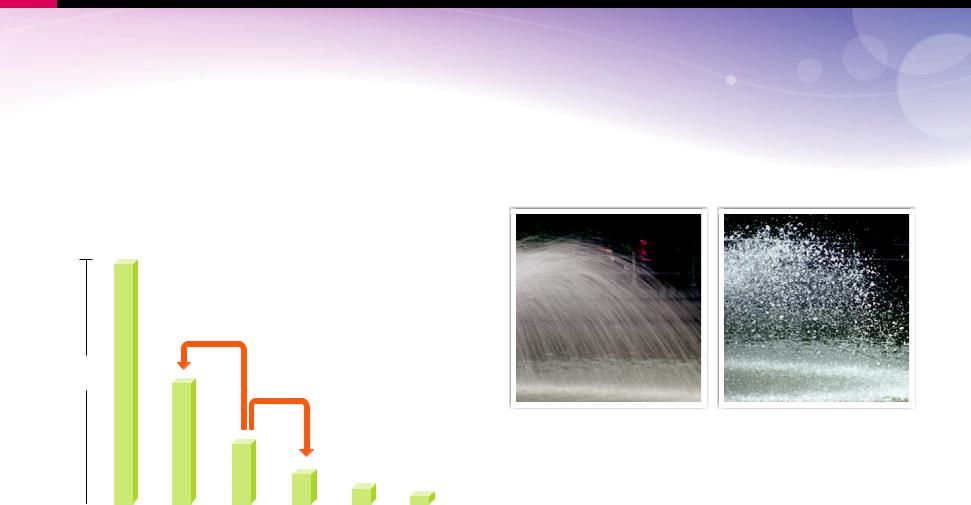
Concepts in Photography
Shutter speed
Shutter speed refers to the amount of time it takes to open and close the shutter, and it is an important factor in the brightness of a photo, as it controls the amount of light which passes through the aperture before it reaches the image sensor.
Usually, the shutter speed is manually adjustable. The measurement of the shutter speed is known as the “Exposure Value” (EV), which is marked in intervals of 1 s, 1/2 s, 1/4 s, 1/8 s, 1/15 s, 1/1000 s, 1/2000 s, and so on.
|
|
+1 EV |
|
|
|
Exposure |
|
|
|
|
|
|
|
|
-1 EV |
|
|
1s |
1/2 s |
1/4 s |
1/8 s |
1/15 s |
1/30 s |
|
|
Shutter Speed |
|
|
|
Therefore, the faster the shutter speed, the less light will be let in. Likewise, the slower the shutter speed, the more light will be let in.
As the photos below illustrate, a slow shutter speed allows more time to let light in, so the photo becomes brighter. On the other hand, a fast shutter speed allows less time to let light in and the photo becomes darker and more easily freezes subjects in motion.
0.8 s |
0.004 s |
18
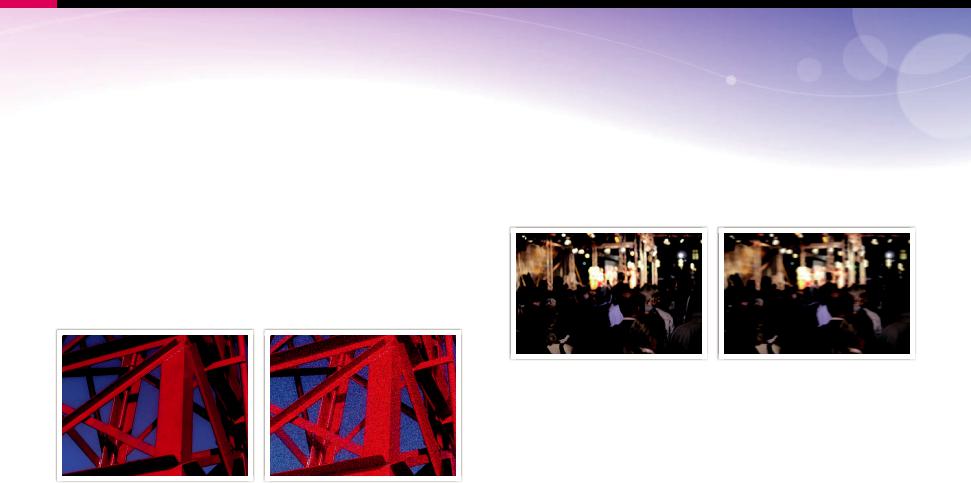
Concepts in Photography
ISO sensitivity
The exposure of an image is determined by the sensitivity of the camera. This sensitivity is based on international film standards, known as ISO standards. On digital cameras, this sensitivity rating is used to represent the sensitivity of the digital mechanism that captures the image.
ISO sensitivity doubles as the number doubles. For example, an
ISO 200 setting is capable of capturing images at twice the speed of an ISO 100 setting. However, higher ISO settings can result in “noise”—small specks, spots, and other phenomena in a photo that give the shot a noisy or dirty appearance. As a general rule, it is best to use a low ISO setting to prevent noise in your photos, unless you are shooting in darkened environments or at night.
Changes in the quality and brightness according to ISO sensitivity
Because a low ISO sensitivity means the camera will be less sensitive to light, you need more light to have an optimal exposure. When using a low ISO sensitivity, open the aperture more or reduce the shutter speed to allow more light to enter the camera. For example, on a sunny day when light is abundant, a low ISO sensitivity does not require a slow shutter speed. However, in a dark place or at night, a low ISO sensitivity will result in a blurry photo. Therefore, it is recommended to increase the ISO sensitivity by a moderate amount.
A photo captured with a tripod and high |
A blurred photo with a low ISO sensitivity |
ISO sensitivity |
|
19
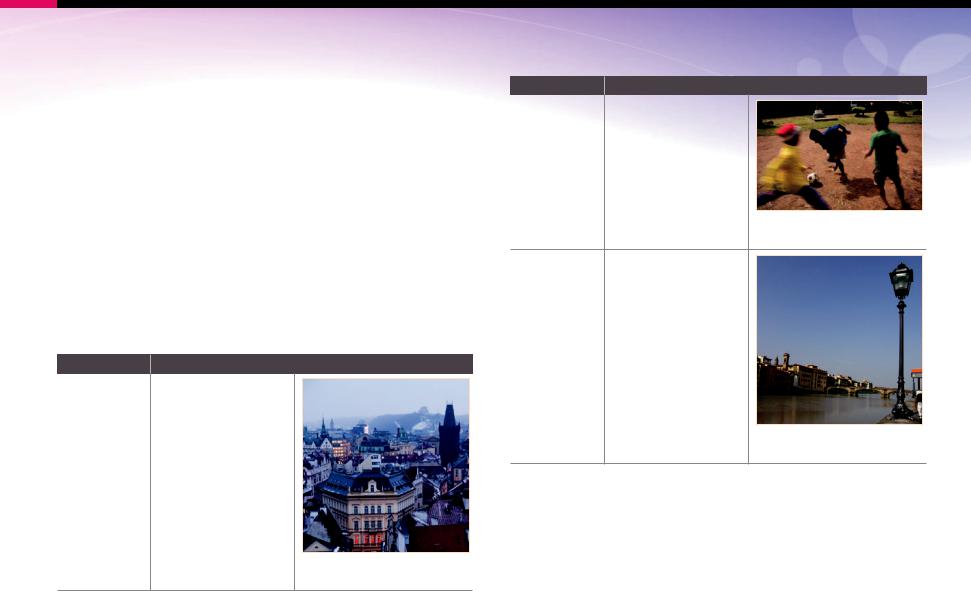
Concepts in Photography
How the aperture setting, shutter speed, and ISO sensitivity control exposure
The aperture setting, shutter speed, and ISO sensitivity are closely interconnected in photography. The aperture setting controls the opening that regulates the light that enters the camera, while the shutter speed determines the length of time that light is allowed to enter. ISO sensitivity determines the speed at which the film reacts to light. Together, these three aspects are described as the triangle of exposure.
A change in shutter speed, aperture value, or ISO sensitivity can be offset by adjustments to the others to maintain the amount of light. The results, however, change according to the settings. For example, shutter speed is useful in expressing movement, aperture can control the depth of field, and ISO sensitivity can control the graininess of a photo.
Settings |
Results |
|
|
Aperture |
Wide aperture |
= more light |
|
value |
Narrow aperture |
|
= less light |
Wide = small depth of field
Narrow = large depth of field
Settings |
Results |
Shutter speed
Fast speed = less light Slow speed = more light
Fast = still
Slow = blurry
High sensitivity
ISO sensitivity
= more sensitive to light Low sensitivity
= less sensitive to light
High = more grainy
Low = less grainy
20
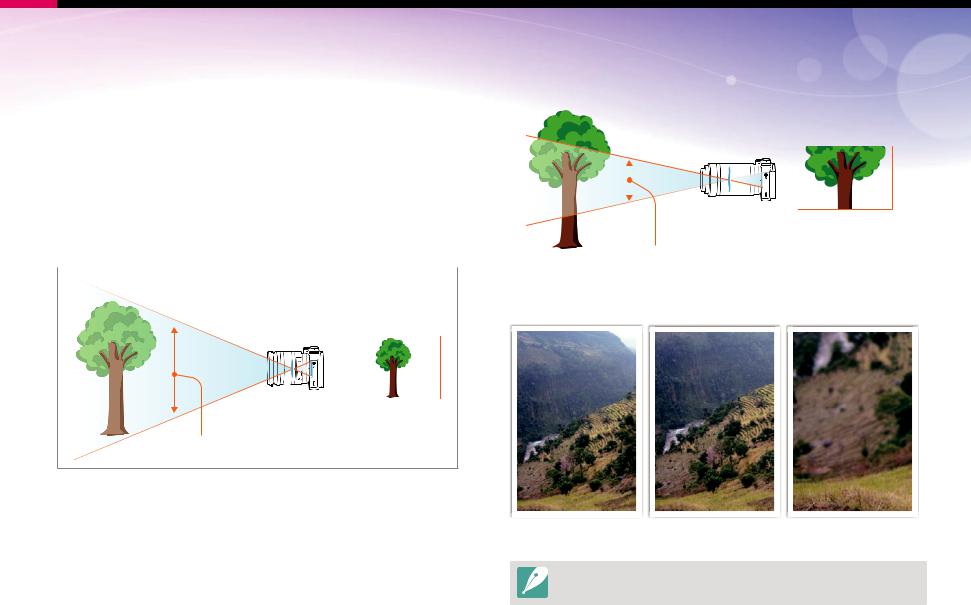
Concepts in Photography
Correlation between focal length, angle, |
Long focal length |
|||
and perspective |
|
|
|
|
|
|
|
||
Focal length, which is measured in millimeters, is the distance between |
|
telephoto lens |
||
the middle of the lens to its focal point. It affects the angle and perspective |
|
|
|
|
of captured images. A short focal length translates into a wide angle, |
|
|
|
|
|
|
|
||
which allows you to capture a wide shot. A long focal length translates |
|
|
|
|
|
|
|
||
into a narrow angle, which allows you to capture telephoto shots. |
|
|
telephoto shot |
|
|
|
|
|
|
Short focal length |
narrow angle |
|||
|
|
|
|
|
|
|
|
|
|
|
|
Look at these photos below and compare the changes. |
||
wide-angle lens |
|
|
|
|
wide shot
wide angle
18 mm angle |
55 mm angle |
200 mm angle |
Normally, a lens with a wide angle is suitable for shooting landscapes and a lens with a narrow angle is recommended for shooting sports events or portraits.
21

Concepts in Photography
Depth of field
Portraits or still-life photos mostly acclaimed by people are the ones on which the background is out of focus so the subject looks pronounced. Depending on the focused areas, a photo can be blurred or sharpened. This is called ‘a low DOF’ or ‘a high DOF’.
The depth of field is the focused area around the subject. Therefore, a small DOF signifies that the focused area is narrow and a large DOF means the focused area is wide.
A photo with a small DOF, which stresses the subject and makes the rest of it blurred, can be obtained by using a telescope lens or selecting a low aperture value. Conversely, a photo with a large DOF which shows all the elements on the photo sharply focused can be achieved by using a wide angle lens or selecting a high aperture value.
What controls out-of-focus effects?
DOF depends on aperture value
The wider the aperture is (namely the lower the aperture value), the lower the DOF becomes. Under the condition where the other values including shutter speed and ISO sensitivity are equal, a low aperture value leads to a photo with a low DOF.
55 mm F5.7 |
55 mm F22 |
Small Depth of Field |
Large Depth of Field |
22

Concepts in Photography
DOF depends on focal length
The longer the focal length is, the lower the DOF gets. A telescope lens with a longer focal length than a telescope lens with a short focal length is better to capture a photo of a low DOF.
A photo captured with a 18 mm |
A photo captured with a 100 mm telescope |
telescope lens |
lens |
DOF depends on the distance between the subject and the camera
The shorter the distance between the subject and the camera is, the lower the DOF gets. Therefore, taking a photo close to a subject can result in a photo of low DOF.
A photo captured with a 100 mm telescope lens
A photo captured close to the subject
23
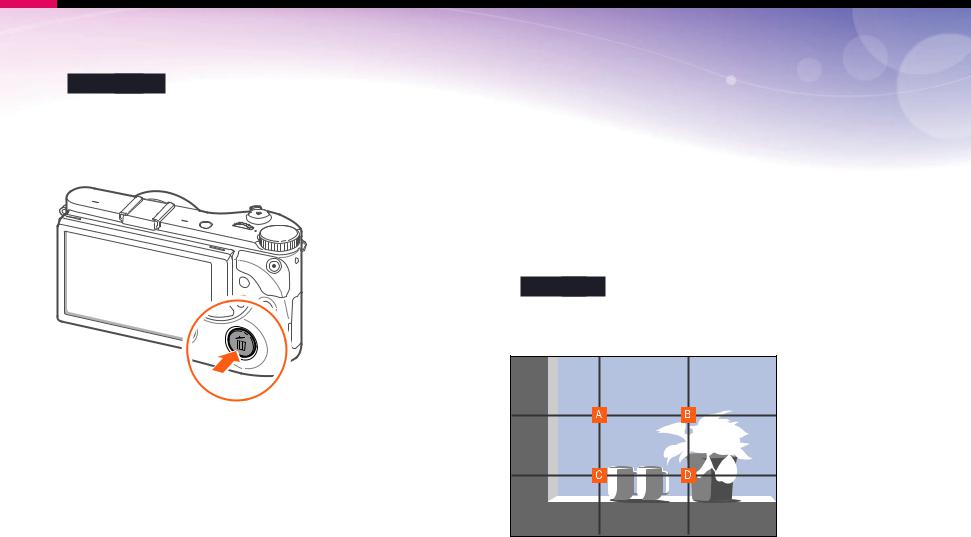
Concepts in Photography
Optical preview
You can press the Custom button to view the optical preview before capturing a photo. The camera adjusts the aperture to the predefined settings and shows the results on the screen. Set the Custom button to
Optical preview. (p. 150)
Composition
It is fun to capture a photo of the beauty of world with a camera. No matter how the world is beautiful, however, a poor composition cannot capture the beauty of it.
When it comes to composition, it is very important to prioritize subjects.
Composition in photography means arranging objects in a photo. Usually, abiding by the rule of thirds leads to a good composition.
Rule of Thirds
To use the rule of thirds, divide the image into a 3x3 pattern of equal rectangles.
To compose photos that best emphasize the subject, make sure the subject is located at one of the corners of the center rectangle.
24

Concepts in Photography
Using the rule of thirds will create photos with stable and compelling |
Photos with two subjects |
compositions. Below are a few examples.
If your subject is in one corner of the photo, it creates an unbalanced composition. You can stabilize the photo by capturing a second subject in the opposite corner to balance the weight of the photo.
Subject 2 |
Subject 2 |
Subject 1 |
Subject 1 |
Unstable |
Stable |
When taking landscape photos, centering the horizon will create an unbalanced effect. Give more weight to the photo by moving the horizon up or down.
Subject 1
Subject 1
Subject 2
Subject 2
Unstable |
Stable |
25

Concepts in Photography
Flash
Light is one of the most important components in photography. It’s not easy, however, to have an enough amount of light anytime and anywhere. Making use of a flash allows you to optimize light settings and create a variety of effects.
Flash, also known as strobe or speed light, helps to create adequate exposure in low-light conditions. It is also useful in light-abundant situations. For example, flash can be used in compensating the exposure of a subject’s shadow or capturing clearly both the subject and the background in backlit conditions.
Before correction |
After correction |
Flash guide number
The model number of a flash refers to the flash’s power, and the maximum amount of light created is represented by a value known as a “guide number.”The bigger the guide number, the more light is emitted from the flash. The guide number is achieved by multiplying the distance from the flash to the subject and the aperture value when the ISO sensitivity is set to 100.
Guide number = Flash to Subject Distance X Aperture value
Aperture value = Guide number / Flash to Subject Distance
Flash to Subject Distance = Guide number / Aperture value
Therefore, if you know the guide number of a flash, you can estimate an optimum flash to subject distance when setting the flash manually. For example, if a flash has a guide number of GN 20 and is 4 meters away from the subject, the optimal aperture value is F5.0.
26

Concepts in Photography
Bounce Photography
Bounce photography refers to the method of bouncing light off of the ceiling or walls so that the light spreads evenly over the subject. Normally, photos captured with flash may appear unnatural and cast shadows. Subjects in photos captured with bounce photography cast no shadows and look smooth due to evenly spread light.
27

Chapter 1
My Camera
Learn about your camera’s layout, display icons, lens, optional accessories, and basic functions.

My Camera
Getting started
Unpacking
Check your product box for the following items.
Camera |
AC adapter/USB cable |
Rechargeable battery |
External flash |
(including the body cap and hot-shoe |
|
|
|
cover) |
|
|
|
|
|
|
|
|
|
|
|
Software CD-ROM |
Adobe Photoshop Lightroom DVD-ROM |
Quick Start Guide |
Strap |
(User manual included) |
|
|
|
• The illustrations may differ from your actual items.
•You can purchase optional accessories at a retailer or a Samsung service center. Samsung is not responsible for any problems caused by using unauthorized accessories. For information about accessories, refer to page 195.
29
